Since long time, it was known about the healing qualities of rosehips. For treatment, not only plant fruits are used, but also delicate petals with leaves and even roots. Today, traditional medicine has recognized that rosehip has a diuretic, soothing, antibacterial property and contains vitamins. Making blanks at home is quite simple if you know the terms and rules of collecting rosehips, as well as what is necessary for drying it.
Content
When to collect rosehips, features and deadlines
The collection of fruits, petals, roots and foliage of rosehips is for different times. For each position there is a certain period in which the raw materials contain the maximum number of useful elements. To obtain a therapeutic effect, it is important to observe the collection period and correctly select material for the drying.
When to collect rosehip berries
Many housewives are wondering: "What kind of rosehip is collecting for the winter for drying?" It turns out that a different degree of maturity of the berries has a unequal therapeutic effect. During ripening, rosehip berries acquire bright shades of red and become soft when pressed. Such fruits are not suitable for blanks. It is recommended to collect more shorter berries, which can be determined on a solid surface with a glossy or matte skin. For drying, choose large specimens.
In healthy fruits, cups are directed in different directions. If in rosehips they are tightly located near the berry, then such specimens are not suitable for collection. Fruits must be given more time for ripening.
What rosehip berries do you need to collect? Feel free to send fruits to the basket without visible damage, as well as with cups and tail (stalk). Immediately cut them off. In this state, put the fruits to dry. So during drying, vitamins will remain as much as possible in rosehips, the number of which in the process of drying and so decreases.
It is necessary to plan a collection of raw materials on a warm and sunny day. In rainy weather, berries can be nourished by moisture, which will adversely affect the quality of rosehip drying. The preparation of raw materials falls at the end of September - mid -October. It all depends on the region of residence. Therefore, observe weather conditions and check the maturity of the fruit.
Important! To collect rosehips, take woven gloves with you, since the shrub has spikes and you can scratch about them.
It is a mistake to believe that the collection of rosehips should take place after the first frosts. Scientists in the laboratory way proved that during the effects of the cold, part of the nutrients and vitamins in them is lost.
The fruits of different rosehip bushes have different vitamin composition. They differ in the appearance of the berries. The maximum number of nutrient components is located in rosehips with cups directed up. If you abruptly tear the cup on such a berry, then a round hole will form in its place.
The second type of shrub with a low percentage of vitamins in the common people is called "dog rosehip". The fruits of such a plant have cups that are directed down and tightly located to the surface of the berry. If the cup disappears, then a hole with five corners will appear in its place.

When to collect rosehip leaves
Raporous leaves are also useful for valuable nutrients. Their collection begins in the summer, when the leaves become fully developed. Such specimens have a rich green color. It is advisable to trim the raw materials so as not to damage the process.
Each leaf is assembled separately from the twig and shifted into the basket. The collection container must be kept in the shade during the entire collection process. Otherwise, the sun's rays, falling on the leaves, can ruin their delicate surface.
During the preparation of rosehip sheet plates, pay attention to their external condition. Refuse specimens with traces of rot, yellowing and darkening; any damage to insects or lesions of diseases.
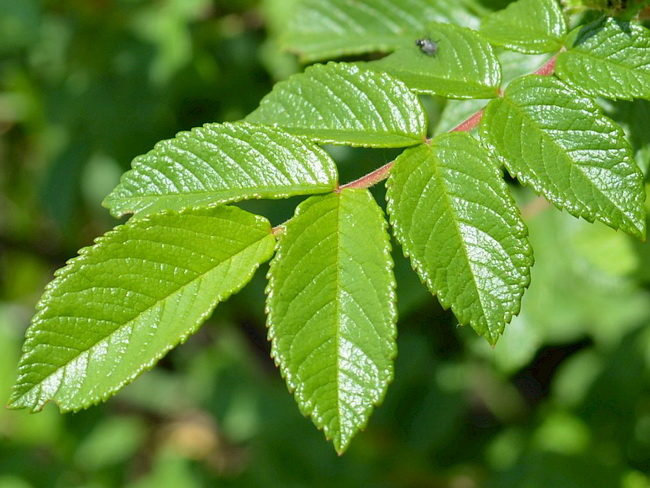
When to collect the petals and flowers of rosehips
Wild rose petals are used not only in folk medicine, but also in cosmetology, and are also widely used in cooking. Both rosehip petals and small flowers are harvested separately. The plant bud has a small inflorescence, which consists of 6 and 8 petals of a white or pink shade. Some rosehip varieties have a more magnificent bud.
It is necessary to harvest flowers and petals of rosehips during the period of active flowering of the plant. This time is in June a month. Unopened buds for drying are not used, as they contain few nutrients.
To collect the rosehip flower is cut along with a small part of the peduncle. Immediately do not break off all the flowers on the bush, let the plant form fruits. The petals break off the flower manually and are transferred to the collection container. Such raw materials need to be dried immediately.
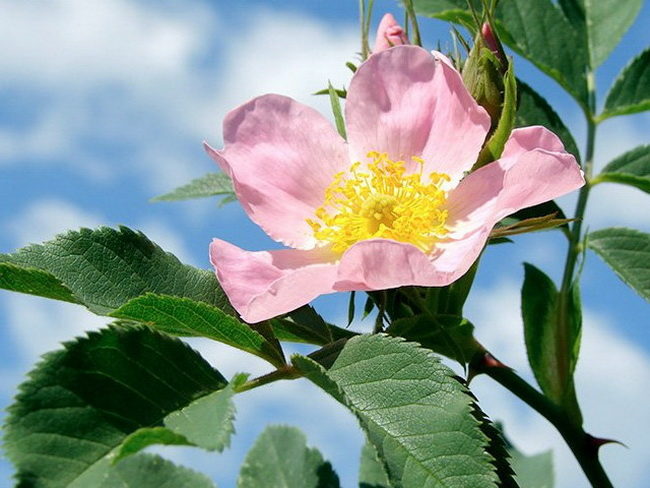
In what month to collect rosehip roots
The root of the plant is more widely used in medicine than the rest of the raw materials. The greatest value is the side roots. They contain more nutrients than the rod of the root system. Therefore, it makes no sense to try to dig the thickest roots of rosehips.
It is necessary to harvest the roots of the shrub in the spring before the period of the formation of buds. This time is in March - April. Also, the end of autumn is suitable for collecting roots (mid -October - November), after the shrub stops fruiting.
It is not necessary to dig a whole bush, one or two shoots will be enough. To do this, bent the side branch to the soil, cut off and dig. For raw materials, only root sprouts on the sides are cut, the central rod is left. The process can be dragged back for the growth of the bush, having previously treated the sections with wood ash.

Rosehip collection dates in central Russia
For the middle lane of the country and in the suburbs, the harvesting collection begins in August and can last until October. It is necessary to have time to prepare raw materials before the onset of the first frosts. According to the folk calendar, the collection of rosehip berries begins after October 1. Our grandmothers believe that only the field of this day of the plant fruits contain a large number of vitamins.

When to collect rosehip in Siberia
For the northern regions of the country and Siberia, the time of collecting harvesting plants falls on the beginning of the mid -August. Autumn here occurs much earlier than in other regions, which means that the ripening time of berries is reduced. But this period for blanks is conditional, it is necessary to monitor the weather and the rosehip ripening process. Check the degree of maturity by the density of the berries and their color.
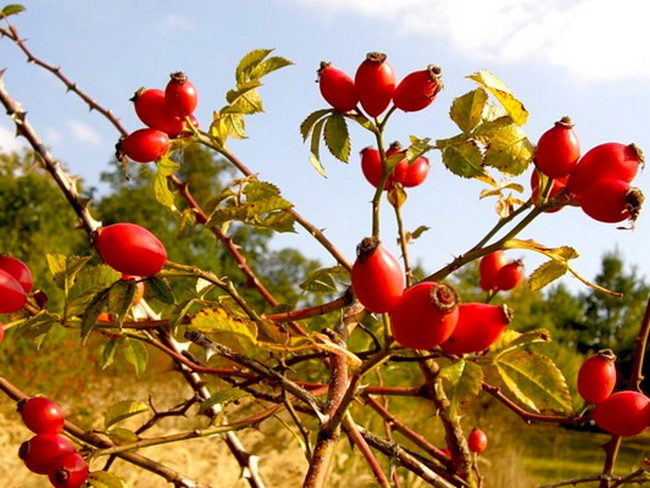
Where to collect rose hips
Some gardeners specially grow rose hips in their areas. So they are confident in conditions of culture and the quality of raw materials. In most cases, fruits and petals gather on the bushes of plants in natural conditions of growth. It is important to determine the collection places in order to make sure of the environmental friendliness of raw materials.
The rosehip bush, like any other plant, absorbs toxins from the environment during growth. Therefore, to collect raw materials, choose plots away from industrial enterprises and roads. It is best to go deep into the forest and find berries there.
The fruits of rosehips ripen as much as possible, which grows on forest edges, cutting and slopes. In such conditions, the bush is provided with nature enough space, moisture and light for full development.

Preparation of rosehip raw materials for drying
The preparatory stage for the collected raw materials of rosehips takes little time, but it is very important for the quality of the finished product. It is not worth postponing the preparation of the collected copies for drying, since the material quickly spoils, especially the petals.
How to prepare rosehip berries for drying for the winter
- Sort out the harvest. Select quality fruits, simultaneously throw off rotten berries, with any damage and crumpled side. Leave the stalk and cup on the fruits. Rinse the rosehip several times under running water. Take advantage of a colander for this. Wash very carefully so as not to damage the tail and cup. If they disappear, then the juice will flow out, and with it most of the useful elements.
- Then dry the fruits from excess moisture. Put them in one layer on a kitchen towel. Leave the rosehip to dry for 1-1.5 hours. To accelerate the drying process from the liquid, get wet the berries on top with napkins or paper towels.
- Some housewives cut each berry before drying and clean the seeds. This procedure will reduce the drying time of rosehips, but will reduce the amount of useful components and vitamin in it. In this form, only tea can be brewed from the fruits.
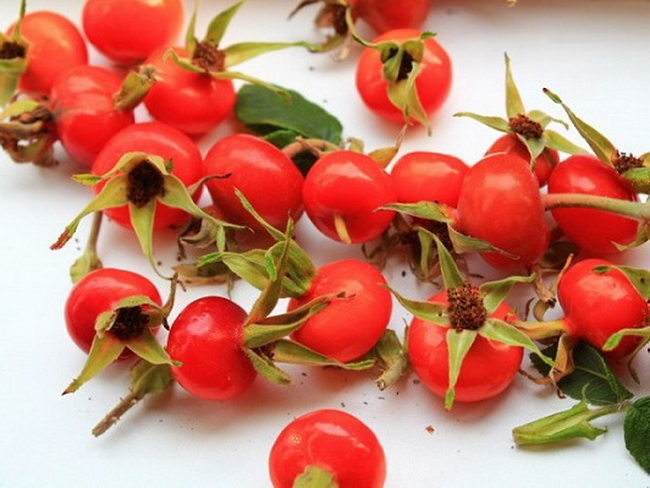
How to prepare rosehip flowers for drying
- It is not recommended to leave petals for a long time without processing, as they quickly fade and deteriorate. Therefore, immediately after collecting colors, cut off all the petals. Carefully inspect each of them. Damaged specimens and damaged put aside. Rinse the petals with water is not recommended.
- If you dry the raw materials, then immediately proceed to the procedure. To prepare jam or sugared petals, act according to the recipe.

How to prepare rosehip leaves for drying
- If you cut off each leaflet from a branch during the collection, then you do not have to go through this procedure again. Otherwise, tear off the leaves from the branches and break through. For blanks, spoiled specimens, leaves with mechanical damage and traces of insect life are not needed.
- Then gently rinse leaf plates in cold water. This must be done to remove dust and other pollution from the surface of the leaves. Lay the washed raw materials on paper or a kitchen towel for drying. Place the leaves in one layer. When the moisture evaporates completely, you can proceed to drying the leaves.

How to prepare the collected roots of rosehips for drying
The rhizomes of plants will require you to more time for preparatory work. For a long time, do not leave the rosehip roots after the collection. They quickly fade and can begin to deteriorate if there are traces of rot.
- Soak the roots in cold water for a couple of hours. After that, rinse thoroughly using the brush. But only this time wash under running water. Put raw materials on napkins for drying for 3-4 hours.
- After the specified period of time, cut each root into several small parts. For this part of rosehip blanks, preliminary drying is required. Place the raw materials in a cool, but in a dry and darkened room. Dry rosehip roots for 2-3 days. Be sure to ensure good air circulation for this time. Then you can proceed to the chosen drying method.

How to dry rosehip at home
The collected blanks are necessarily drying, otherwise they quickly deteriorate. The exception is the petals from which the housewives boil jam or are used in cosmetology. The raw materials should be processed immediately after the preparation, so the maximum of vitamins and useful elements will be preserved in it.
How to dry the collected rosehip berries
There are a large amount of drying methods from rosehip blanks. You can use the most primitive option or use special equipment. But, using a particular method of drying, it is important to observe the rules for processing raw materials. Only qualitatively dried blanks retain their qualities, taste and color, and also do not stick together.
How to dry rosehip fruits in the oven
The easiest method for drying rosehip berries, because the oven is in almost every kitchen. Drying blanks is best on one baking sheet, because the heat in the oven is not distributed evenly, and you will have to look after the berries all the time. But if you have a convection function in the oven, then you can use several trays at once.
- Cover the baking sheet with parchment for baking. Put the rosehip fruits dried from moisture on top. Place the berries in one layer and not too tightly to each other. Hot air should blow each fruit from all sides for uniform drying.
- Heat the oven to 45 degrees, set the trays with rose hips. Leave the door on the oven a little open. This will allow air to circulate freely inside the oven, and at that moment moisture evaporated. If you close the door, then the berries will not dry, but bake. You can put a kitchen towel between the door and the oven.
- After a few hours, increase the temperature in the oven to 70 degrees. The whole procedure will pass in 8-9 hours, depending on the size of the berries. During heat treatment, the fruits must be turned over so that they do not burn. In the last hours of drying, check the readiness of raw materials. Small berries are dried faster than large, so they must be taken earlier.
- When the rosehip becomes completely dry, do not rush to transfer it to storage bags. Give the berries to cool completely. It will take it for an hour and a half. Only then proceed to the storage package.
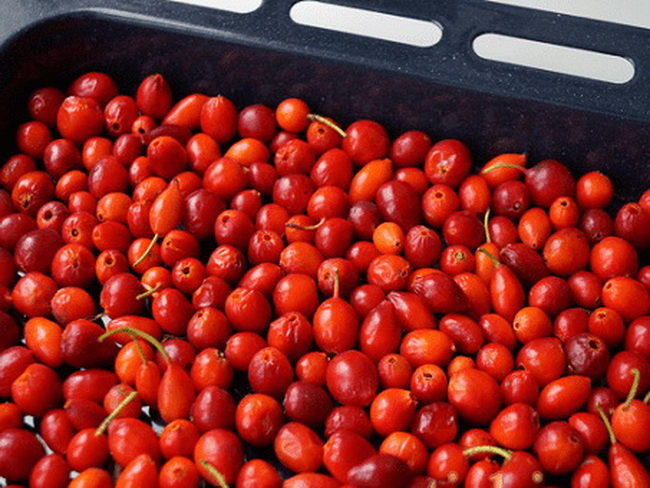
How to dry rosehip fruits in an electric dryer
You can simplify the drying of rosehip berries using a drying apparatus. So you do not have to monitor the temperature and position of the door in the oven, you can not turn the fruits. The flow of hot air in the device will evenly dry the rosehip.
- After preparing the berries, place them on the dryers of the dryer in one layer. Set the containers one on the other, cover the upper row with a special lid. Next, follow the instructions for your dryer model. The only condition for drying rosehips is that the temperature should not drop to 50 and not exceed 70 degrees.
- For drying berries, you must first set the temperature on the device maximum. So moisture will evaporate faster, and the crust on the fruits will harden. Then, after 3-4 hours, the temperature should be reduced to 50 degrees and wait for the end of the process. In total, the rosehip dryer in the electric dryer will take from 6 to 8 hours. At the same time, every hour it is necessary to change the lower places with the upper tray for uniform drying.
Important! Rock hot fruits first cool at room temperature, then transfer to containers for storage.

How to dry rosehip berries in other ways
- The most preferred option for drying the workpiece is a natural way. But it requires significant efforts on your part. For drying, it is necessary to prepare a dark place, well ventilated and with low air humidity.
- It is also important to prevent direct rays of the sun on berries. As you know, ultraviolets destroys vitamins and other beneficial elements in the fruits. Therefore, it is forbidden to dry the berries of the plant on the street or balcony.
- Berries are prepared in the usual way and are very well dried from moisture. Then, in one layer, they are laid on cardboard or parchment. You can also use clean fabric without a pattern. It is important to choose an even place for drying blanks so that the berries do not roll.
- Drying will take several days. At the same time, turn the berries every 12 hours. So the surface of the fruit will dry evenly. This method of processing raw materials, although it is considered natural, but it is very long. For maximum preservation in the rosehip of vitamins, it is necessary to dry the blanks as soon as possible.

How to dry rosehip petals
The most tender part of rosehip blanks requires maximum caution and compliance with drying conditions. If you dry the petals incorrectly, then they can be spoiled. It is not recommended to use oven or dryer for drying the petals. Only a natural way of drying is required.
Put each petal on fabric or thick paper. Lay the raw materials with a thin layer. Place the tray with rosehip petals in the shade and dry for about 2 weeks. Make sure that the sun's rays do not fall on the blanks, otherwise the sun will quickly ruin them. Often turn over the petals for uniform drying. After completely drying the petals, put in the room, let stand and pack it on storage tanks.
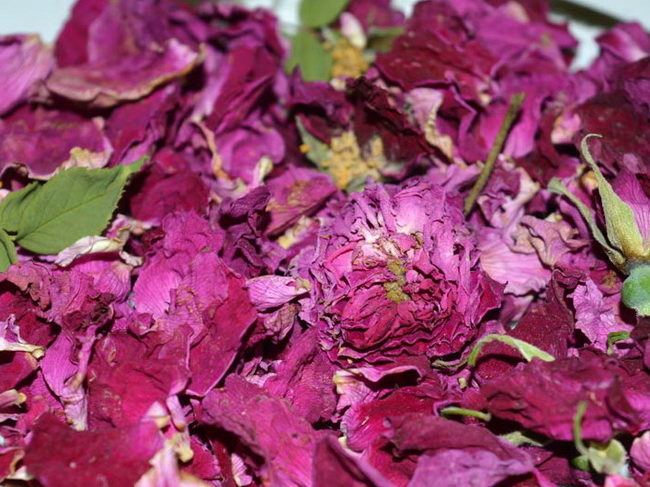
How to dry rosehip leaves correctly
The deciduous plates of the plant are not as delicate as petals, but also require careful drying. The drying process naturally is the same as that of the petals, only time will be required. It is allowed to use an electric dryer, but only at low temperature.
- After preparation, put the leaves into one layer on the tray of the dryer. Install on the device, set the temperature minimal. Drying of rosehip leaves in an electric dryer will take 2-3 hours. Therefore, do not leave the device for a long time. Often turn the leaves so that they dry evenly.
- You can determine the readiness of drying the leaves by their brittle structure. Give the finished raw materials to cool well, only then determine for storage.

How to dry rosehip root
The root of the plant can be dried in an oven or electric dryer, but only the temperature of the devices should not exceed 50 degrees. After preliminary drying, put the roots on a baking sheet or a dryer tray. The layer should be single. During drying the fruits in the oven, gradually increase the temperature, and in the electric dryer, on the contrary, reduce. Do not forget to leave the oven door slightly open.
The roots should also be turned over during drying. The drying time will depend on the different thickness of the processes. Therefore, check the condition of the roots as often as possible. Given the finished raw materials to cool and go to the storage package.
Rosehip roots can be dried in a natural way, but this will take much more time. Disable clean and chopped specimens on thick paper and leave in a dark room. The room during the drying should be well ventilated, contain the minimum percentage of humidity and not be cold.
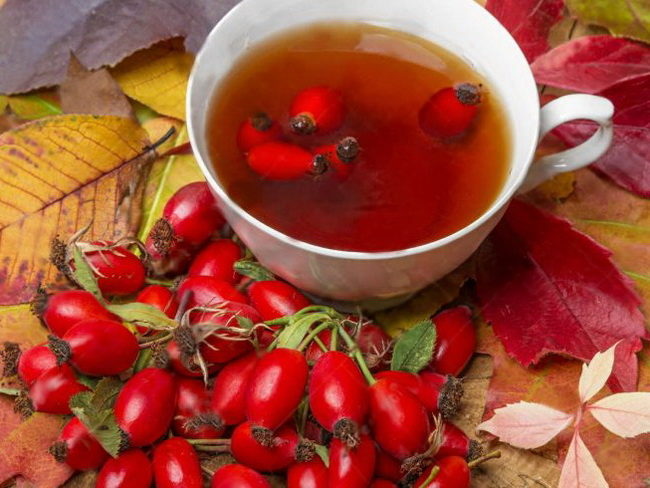
How to store rosehip blanks in winter
In addition to preparing blanks and their further drying, it is necessary to properly organize the storage of raw materials. Rosehip can even deteriorate in dried form. First remove dry tails. For this, do not break them, but rub them against each other. So you can maintain the integrity of the berries.
- After drying and cooling, the rosehip should be put in a package of cardboard and tightly closed. Leave the berries alone for 2-3 days. So the remaining moisture will be evenly distributed between the fruits and the surrounding air.
- Store rosehips in dry containers with a dense lid. But it is best to use bags sewn from fabric. Immediately cook tea or make tinctures from dried rosehips. Give the berries to move away from drying for several days.
- Rosehip petals require careful storage, so it is necessary to use glass or ceramic containers. In them, the petals will not break during storage. Gently shift dry blanks to containers. The capacity cover should be tightly closed. Store petals on the shelf away from heating devices and sunlight. The raw materials of one season can be stored only 2 years.
- The leaves of the plant in a dried state are stored similarly as rosehip petals. Use containers with a dense lid and store in a dark but dry place. Leaves can be consumed only 12 months after drying.
The rhizomes of the plant are allowed to be stored in bags or bags, but only made of fabric. It is important that the air can pass through the material. It is not recommended to store plant roots in crushed form, since it quickly oxidizes from contact with air. Therefore, if you need raw materials for the preparation of tea or infusion, then grind a small amount directly before use. Storage of rosehip roots is allowed for 2 years.

It is not difficult to prepare rosehip raw materials for the winter if you know small secrets. In order for the raw materials to benefit the body, it is important to know not only the timing of the collection of raw materials, but also at what temperature to dry the rosehip. On the basis of rosehips, teas are brewed, jelly is prepared and even jam is cooked. Be healthy!









Comments
a couple of years ago, there was no side of metrogils from the same problem, there were no side effects ...
I’m not a fan of peeling at all, it saves from acne of metrogil, it also smoothes it ...
Great article! ...
I take the second course of the Capsules Climafite 911. The tides went very quickly. It became calmer, irritability went away and I sleep well ...
i also noticed - it is worth nervous, everything immediately affects the face. Therefore, I try to avoid conflicts and unpleasant people. Of the creams, I like Miaflow from wrinkles - smoothes not only small wrinkles ...